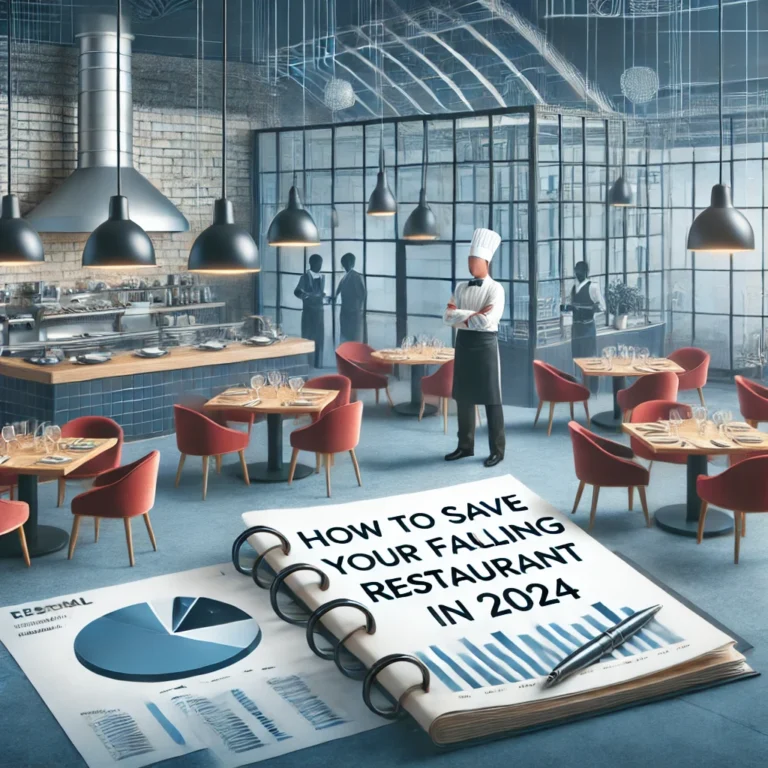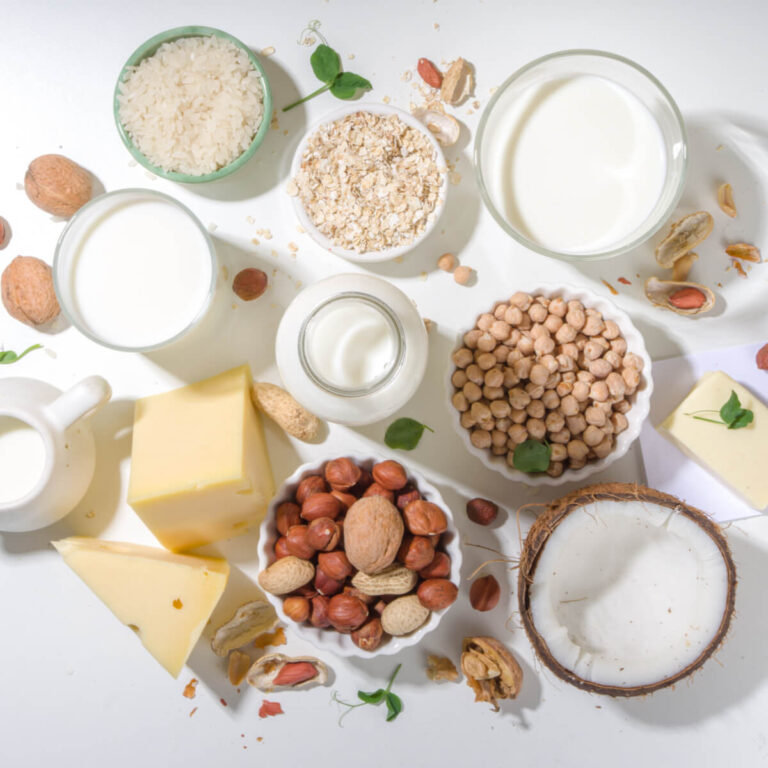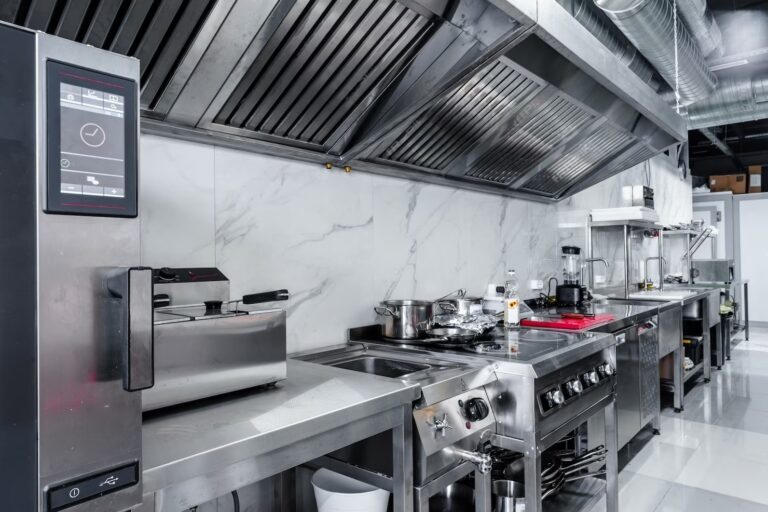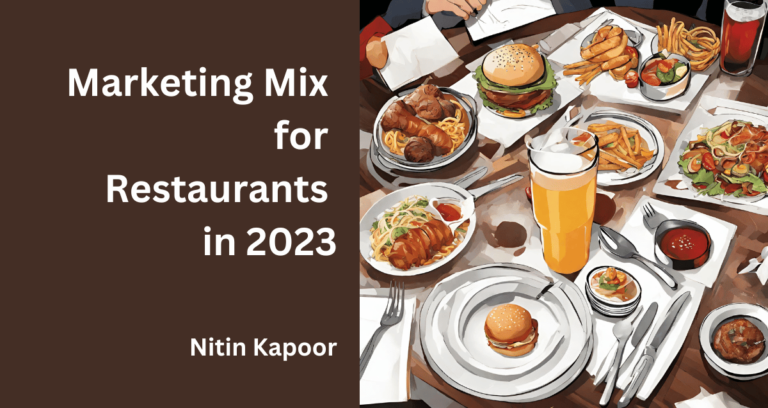The Importance of Food Presentation
Food presentation in restaurants is an important aspect of the restaurant industry because it is the first impression a guest has of a dish before tasting it. A guest’s perception of the quality and value of a dish can be influenced by how food is presented. Food presentation can affect a restaurant’s reputation and online presence in today’s world, where social media and online reviews are ubiquitous.
A beautifully presented dish can be visually appealing and enticing, increasing a guest’s appetite and improving their dining experience. A poorly presented dish, on the other hand, can be unappealing and unappealing, negatively impacting a guest’s dining experience and the likelihood of returning or recommending the restaurant to others.
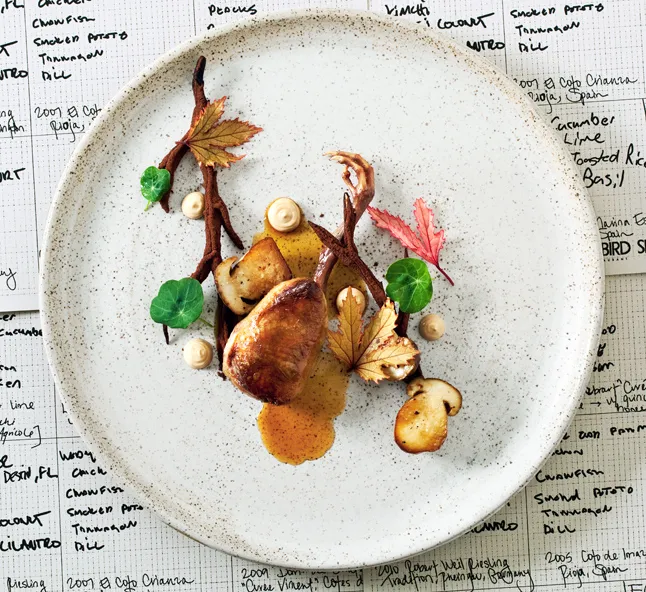
Food presentation, in addition to its aesthetic value, can influence the taste and texture of a dish. A well-arranged and presented dish can enhance the flavors and textures of the ingredients, making them more enjoyable to eat. A dish’s presentation can also communicate information about its ingredients, cooking method, and cultural influences.
As a result, it is critical for restaurants to pay attention to food presentation and ensure that dishes are visually appealing, consistent, and appetizing. This can enhance the overall dining experience, boost guest satisfaction, and contribute to the restaurant’s success.
Plating Techniques for Food Presentation
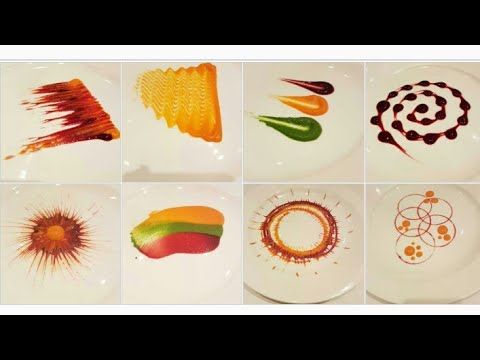
Overview of different plating techniques used in restaurants & Step by Step guide to some of the most popular techniques
The various ways in which food can be arranged and presented on a plate to enhance its visual appeal are referred to as plating techniques. Different plating techniques can produce a variety of effects, ranging from simple and elegant to bold and dramatic.
Here’s a step-by-step guide to some of the most popular restaurant plating techniques:
Classic Plate:
- Begin by placing the main protein in the center of the plate.
- Wrap the protein in the starch and vegetable sides.
- To add color and visual interest to the plate, use a sauce or garnish.
Stack Plate:
- Begin with a base layer of mashed potatoes or pureed vegetables on the plate.
- Place the protein layer on top of the base layer.
- On top of the protein, add another layer of vegetables or sides.
- To add color and visual interest to the plate, use a sauce or garnish.
Landscape Plate:
- Start by making “hills” and “valleys” of purees or sauces on the plate with a spoon or squeeze bottle.
- Place the protein in the center of the plate, on top of one of the “hills.”
- Arrange the vegetables and sides around the protein, creating visual interest and texture with the “hills” and “valleys.”
Minimalist Plate:
- To add color and visual interest to the plate, use a sauce or
- Place the main protein in the center of the plate to begin the minimalist plate.
- Place one or two sides on the plate in a simple and elegant manner.
- Make use of negative space on the plate to add visual interest and make the ingredients stand out.
- To add color and visual interest to the plate, use a sauce or garnish.
Circular Plate:
Continue the circular pattern by adding the starch and vegetable sides around the protein.
To add color and visual interest to the plate, use a sauce or garnish. Add the starch and vegetable sides around the protein, creating visual interest with negative space.
To add color and visual interest to the plate, use a sauce or garnish.
Freeform Plate:
Begin by arranging the ingredients on the plate in a freeform or abstract pattern, like a canvas.
To add movement and texture to the plate, use sauces, purees, or garnishes.
Experiment with various color combinations and shapes to create a visually appealing and one-of-a-kind dish.
These are just some basic plating techniques to get you started. Remember that plating is an art with no hard and fast rules, so don’t be afraid to experiment and try new things!
Plate Composition for Food Presentation
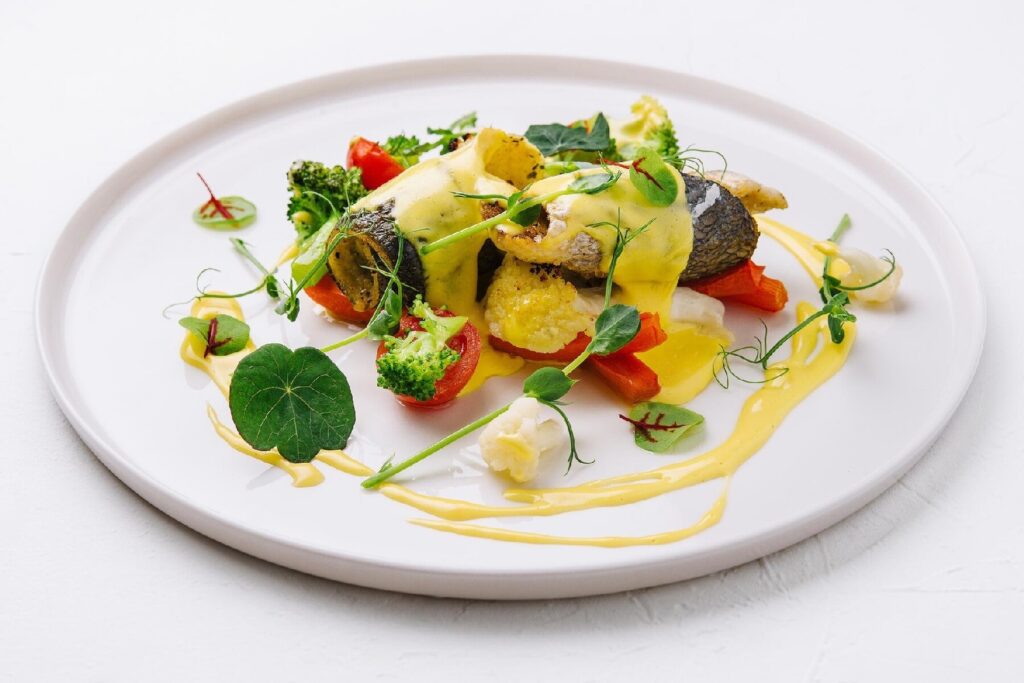
How to compose a visually appealing plate and Tips on creating balance and harmony in a dish
Creating an eye-catching plate is an art form that necessitates careful consideration of several key elements. Here are some ideas for creating a visually appealing plate:
Balance: A visually appealing plate should have color, texture, and shape balance. To add visual interest to the plate, use a variety of colors and textures, and consider the shape and size of each ingredient when arranging them.
Contrast: It is essential in creating a visually appealing plate. Make each ingredient stand out on the plate by using contrasting colors, textures, and shapes. Combining a round protein with long, thin vegetables, for example, can create an eye-catching visual contrast.
Proportion: When creating a plate, keep proportion in mind. Each ingredient on the plate should be in proportion to the others, and the plate should not be overcrowded with too many ingredients.
Negative Space: Just as important as the ingredients themselves is negative space or empty space on the plate. Make use of negative space to add visual interest and make the ingredients stand out on the plate.
Garnishes: Garnishes can enhance the visual appeal and color of a plate. To add color and flavor to the dish, use fresh herbs, edible flowers, or sauces.
Plate Selection: Choosing the right plate is an important step in creating a visually appealing plate. Choose a plate that complements the colors and textures of the ingredients, and when arranging the ingredients, keep the plate’s size and shape in mind.
Consider the order in which the ingredients are displayed on the plate. The protein should be the dish’s focal point, and it should be placed in the center of the plate. Arrange the sides and garnishes to create visual interest and balance around the protein.
Creating balance and harmony in a dish is essential for making it visually appealing as well as delicious. Here are some pointers for achieving balance and harmony in a dish:
Balance the flavors: A dish should have a good mix of sweet, salty, sour, and bitter flavors. To create a harmonious flavor profile, use ingredients that complement and balance each other.
Texture balance: A dish should have a variety of textures, such as crisp, crunchy, and smooth. To make a balanced and satisfying dish, combine ingredients with different textures.
Color balance: A dish should have a variety of colors to be visually appealing. When plating the dish, use a variety of colorful fruits and vegetables and keep the color of the plate in mind.
Using fresh ingredients: It is essential for creating a balanced and harmonious dish. To ensure the best flavor and texture, use ingredients that are in season and at their peak of freshness.
Consider the cooking method: The flavor and texture of ingredients can be affected by different cooking methods. When selecting ingredients for a harmonious dish, consider the cooking method.
Pay attention to plating: The presentation of a dish can affect its balance and harmony. Consider the arrangement of the ingredients on the plate, and use negative space to add balance and visual interest.
Taste and adjust: As you cook, taste the dish and adjust the seasoning and flavors as needed. This will assist you in achieving the ideal balance of flavors and textures.
To summarize, achieving balance and harmony in a dish necessitates careful consideration of the ingredients’ flavors, textures, and colors. You can create a balanced and harmonious dish that is both visually appealing and delicious by using fresh ingredients, considering the cooking method, paying attention to plating, and tasting and adjusting as you cook.
Garnishing importance
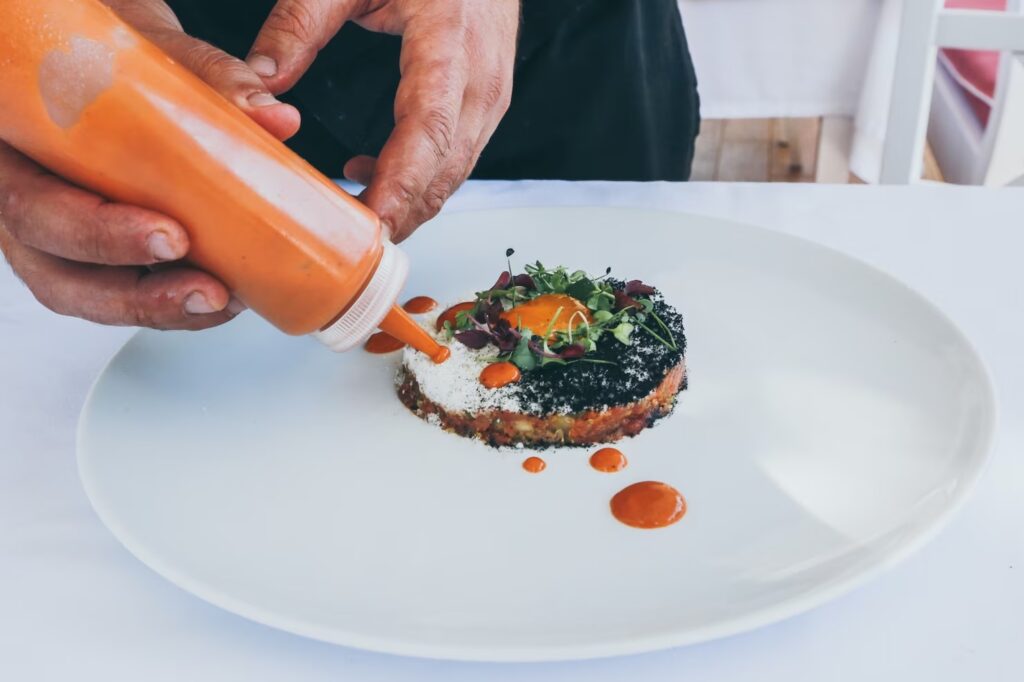
Overview of different types of garnishes and how to use them and tips on using garnishes effectively without overwhelming the dish
Garnishes are visually appealing and flavorful additions to a dish that can improve the overall dining experience. Here’s a rundown of the various types of garnishes and how to use them effectively without overwhelming the dish:
Herbs: Fresh herbs like parsley, cilantro, and basil are frequently used as garnishes to add color and flavor to dishes. They can be used whole, chopped, or as a garnish on top of the dish.
TIP: Use herbs sparingly because their strong flavor can overpower the dish if used in excess.
Edible Flowers: Beautiful and delicate garnishes such as nasturtiums, pansies, and violets can add a pop of color and flavor to a dish.
TIP: Use edible flowers sparingly and only those that complement the flavors of the dish.
Fruits and vegetables: As a garnish, sliced or diced fruits and vegetables can add color and texture to a dish. Popular ingredients include citrus wedges, sliced radishes, and diced tomatoes.
TIP: Choose fresh, in-season fruits and vegetables and cut them into small, bite-sized pieces.
Sauces: As a garnish, sauces such as aioli, salsa, and vinaigrette can add flavor and moisture to a dish.
TIP: Use sauces minimally, and choose a sauce that complements the flavors of the dish.
Nuts & Seeds:
Toasted nuts and seeds, such as pine nuts, sesame seeds, and slivered almonds, can be added to a dish as a garnish to add crunch and texture.
TIP: To ensure even distribution, use nuts and seeds sparingly and chop or grind them into small pieces.
Consider the following tips for using garnishes effectively without overwhelming the dish:
- Choose garnishes that enhance the overall dining experience by complementing the flavors of the dish.
- Garnishes should be used sparingly because they can easily overpower the dish if used in excess.
- Consider the garnish’s size and shape, and use it to add visual interest and balance to the dish.
- Place the garnish on the dish strategically, and use negative space to create balance and visual interest.
Garnishes are an important part of food presentation because they add visual interest while also improving the overall dining experience. You can create a visually appealing and delicious dish without overpowering it by selecting garnishes that complement the flavors of the dish, using them sparingly, and strategically placing them on the plate.
Dishware Selection for Food Presentation
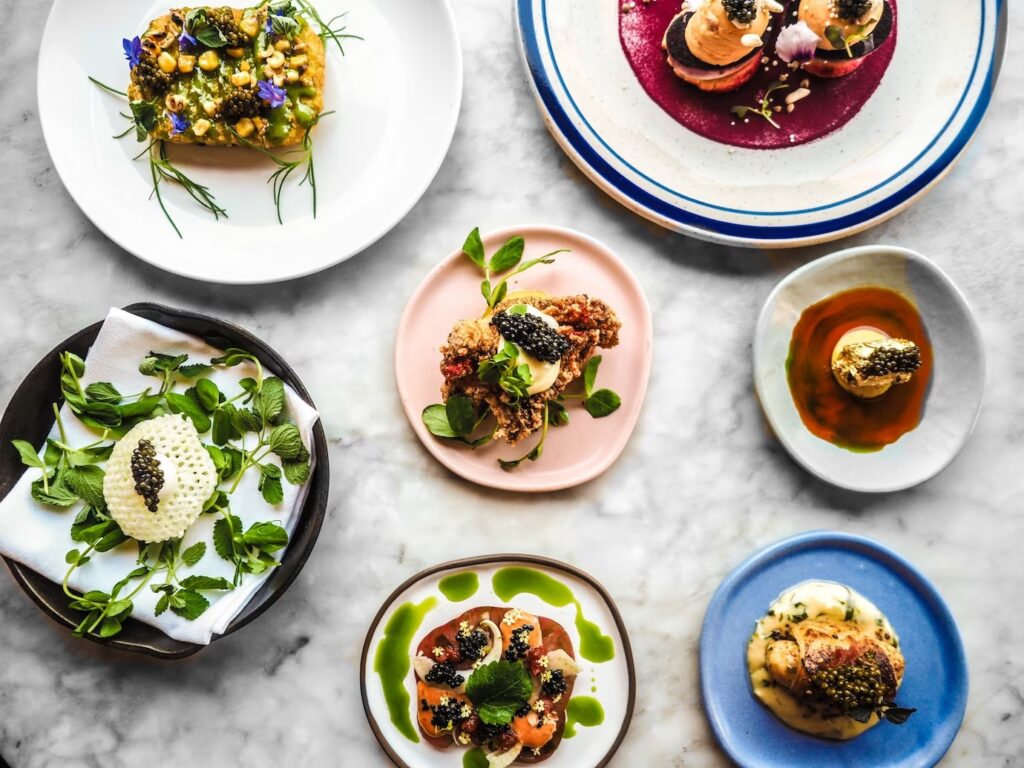
Importance of selecting the right dishware for a dish and Explanation of different types of dishware and when to use them
Choosing the appropriate dishware for a dish is an important aspect of food presentation that can improve the overall dining experience. The right dishware can enhance a dish’s colors, textures, and flavors, as well as create a mood or ambiance for the dining experience. Here’s a rundown of the various types of dishware and when to use them:
- Plates: These are the most common type of dishware used in restaurants and come in a variety of shapes, sizes, and materials. Deep plates are ideal for soups and stews, while flat plates are ideal for dishes with a lot of sauce or liquid.
- Bowls: Deeper than plates, bowls are ideal for serving soups, stews, and salads. They can be made of ceramic, glass, or metal and come in a variety of shapes and sizes.
- Platters: Platters are large, shallow dishes used to serve appetizers, meats, and vegetables. They can be made of a variety of materials, including ceramic, glass, and metal.
- Serving dishes: Side dishes such as mashed potatoes, rice, or vegetables are served in serving dishes. They can be made of a variety of materials, including ceramic, glass, and metal.
- Dessert dishes: Dessert dishes are used to serve desserts such as cakes, pies, and ice cream and come in a variety of shapes and sizes. They can be made of a variety of materials, including ceramic, glass, and metal.
- Glassware: It is used to serve beverages like water, wine, and cocktails. Glassware is designed to enhance the flavors and aromas of various types of beverages.
- Cutlery: Cutlery is used to eat food, such as knives, forks, and spoons. Cutlery is used for different types of food, such as a steak knife for meat and a soup spoon for soup.
Consider the following factors when choosing the appropriate dishware for a dish:
- The type of food served: Different foods necessitate different types of dishware.
- Presentation style: The type of dishware used can be influenced by the presentation style, such as a rustic wooden platter for a casual setting or a fine china plate for a formal setting.
- The mood or ambiance: The type of dishware used, such as colorful plates for a fun and vibrant atmosphere, can help create a mood or ambiance for the dining experience.
Choosing the appropriate dishware for a dish is an important aspect of food presentation that can improve the overall dining experience. You can choose the perfect dishware to complement and elevate the dish by considering the type of food being served, the presentation style, and the mood or ambiance.
Food Presentation
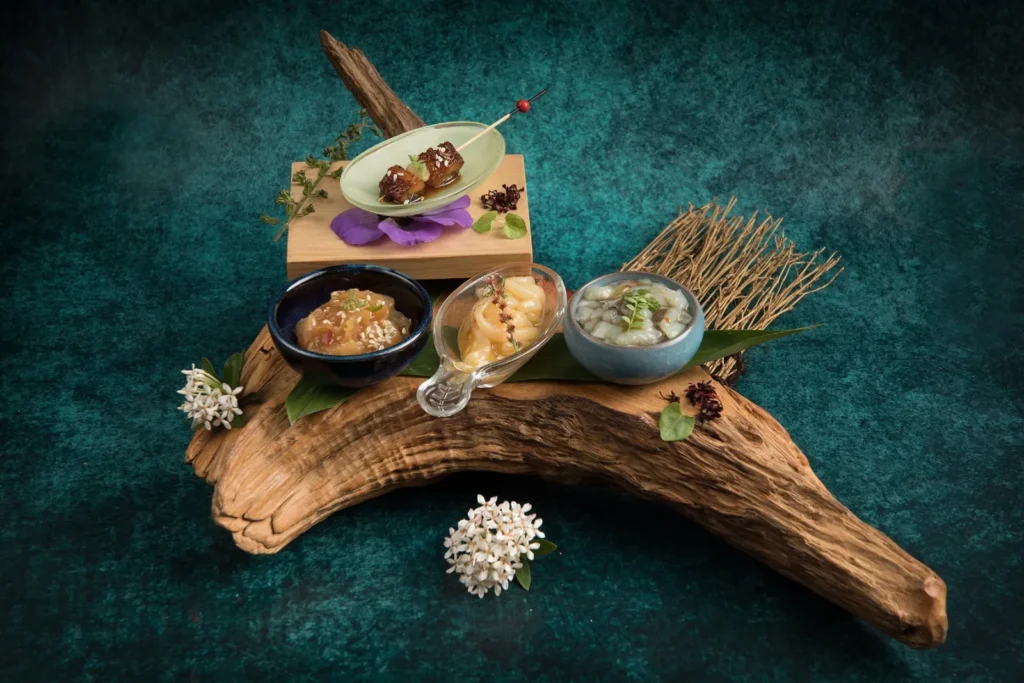
Overview of current trends in food presentation and Tips on staying up-to-date with presentation trends
The world of food presentation is always changing, with new trends emerging every year. Maintaining awareness of these trends is critical for restaurant owners and chefs who want to create visually appealing dishes that stand out in the competitive culinary industry. Here’s an overview of some current trends in food presentation, as well as some tips for staying current with presentation trends:
- Minimalism: One of the current food presentation trends is minimalism, which emphasizes simplicity and clean lines. This style frequently employs negative space and simple plating techniques to draw attention to the natural beauty of the food.
- Natural and Sustainable: Another trend in food presentation is the use of natural and sustainable materials. This includes incorporating natural elements such as leaves and flowers into the presentation, as well as using wooden boards, stone plates, and ceramic bowls.
- Color creativity: Color creativity is becoming increasingly popular in food presentations. To make their dishes stand out, chefs are experimenting with bright, bold colors and unusual color combinations.
- Interactive presentation: This is a trend in which diners are involved in the plating process, allowing them to customize their dishes and create unique presentations.
Tips for staying up-to-date with presentation trends:
- Attend food expos and conferences: Attending food expos and conferences is an excellent way to stay current on the latest trends in food presentation. These gatherings frequently include presentations by industry experts as well as opportunities to network with other professionals.
- Follow food bloggers and social media influencers who specialize in food presentation: Following food bloggers and social media influencers who specialize in food presentation can provide inspiration and keep you up to date on the latest trends.
- Experiment with different techniques: Experimenting with different plating techniques and materials can help you stay ahead of the competition and create one-of-a-kind presentations.
- Team up or collaborate with other chefs: Collaborating with other chefs can provide new perspectives and food presentation ideas.
Restaurant owners and chefs who want to create visually appealing dishes that stand out in the culinary industry must keep up with presentation trends. You can stay ahead of the curve and create presentations that are both beautiful and memorable by attending food expos and conferences, following food bloggers and social media influencers, experimenting with different techniques, and collaborating with other chefs.
Conclusion
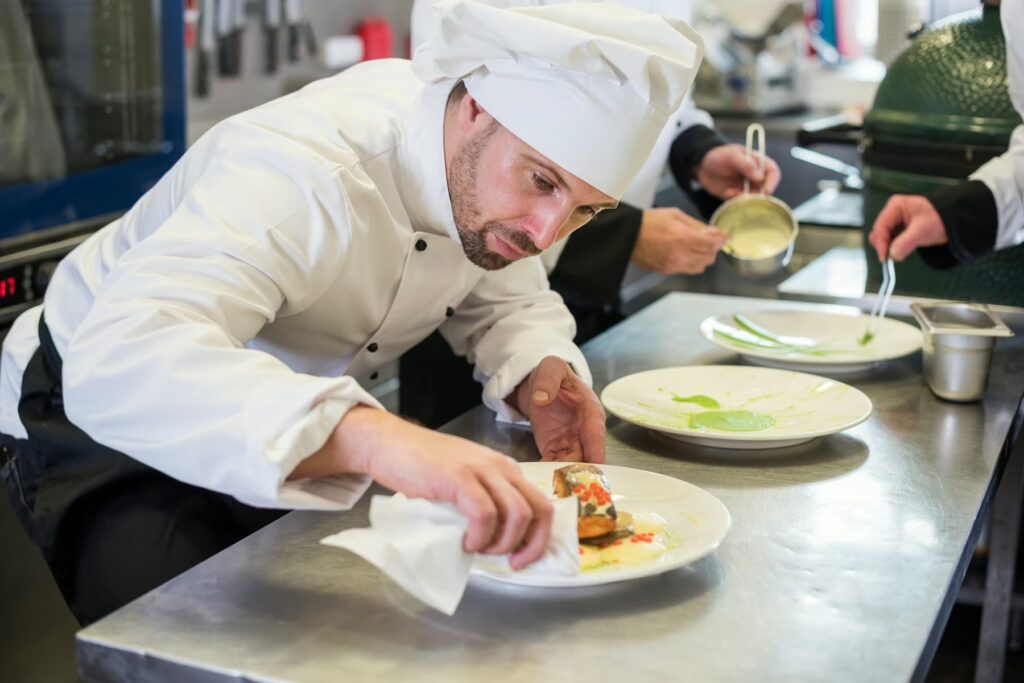
Recap of the importance of food presentation in restaurants and Final tips for improving presentation in a restaurant setting
Food presentation is an important part of the restaurant dining experience. It influences not only the visual appeal of a dish but also its perceived taste and overall impression of the restaurant. A visually appealing dish makes a good first impression, improves the dining experience, and can even increase customer satisfaction and loyalty.
Here are some final pointers for improving restaurant food presentation:
- Select appropriate dishware and garnishes to enhance the dish’s presentation.
- Keep the plating simple and balanced, utilizing negative space and the color, texture, and height principles to create an appealing composition.
- When selecting and preparing the dish, use fresh and high-quality ingredients, and consider the color and texture of each component.
- Stay current with food presentation trends and experiment with new techniques and materials to create unique and memorable presentations.
- Encourage kitchen staff collaboration and creativity, and solicit feedback and suggestions from customers to continually improve dish presentation.
Restaurants can improve the presentation of their dishes, improve the dining experience for their customers, and establish a positive reputation for their establishment by implementing these tips check our work here

